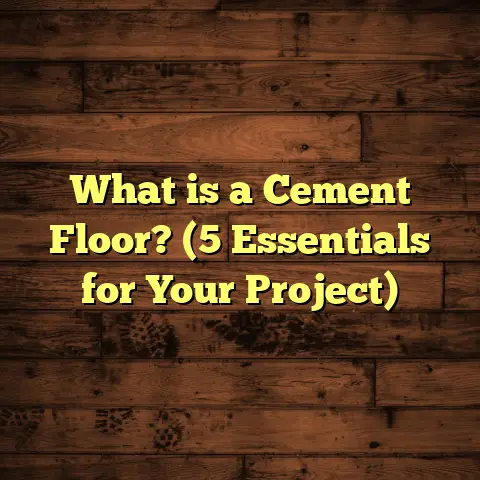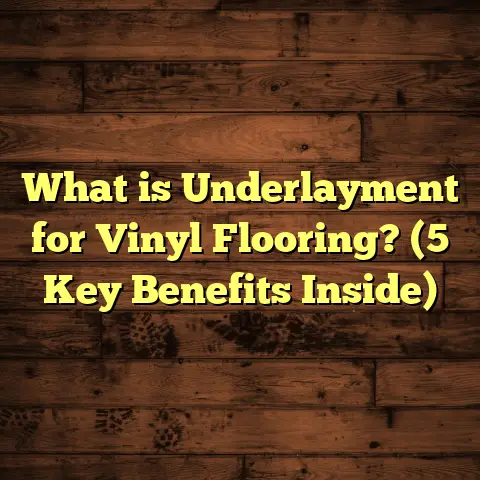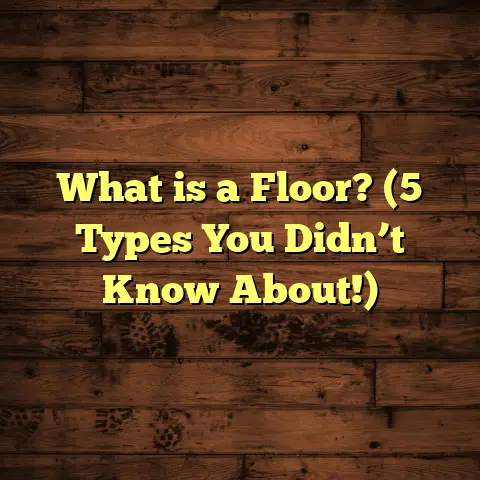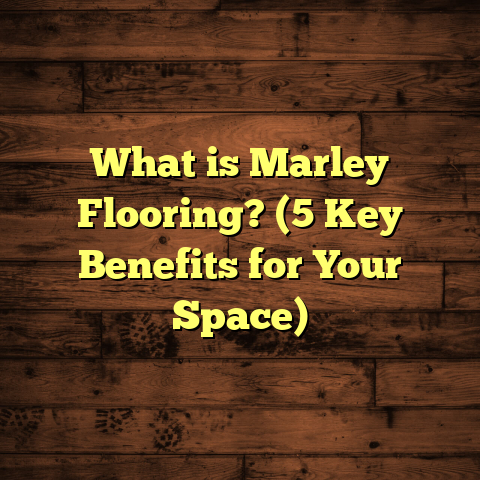What is Seagrass Flooring? (5 Benefits for Eco-Friendly Homes)
I still remember the day I first installed seagrass flooring in a client’s beach house on the coast of Florida. It was a warm, sunny afternoon, and the salty breeze drifted through the open windows while we laid down those natural fiber mats. The homeowners wanted something that would blend perfectly with their eco-conscious lifestyle and coastal aesthetic. After discussing various options like bamboo, cork, and reclaimed hardwood, we finally settled on seagrass flooring. The result was stunning—a warm, textured floor that felt soft underfoot yet durable enough for daily use. That project sparked my curiosity about seagrass flooring, and over the years, I’ve gathered quite a bit of knowledge about its properties, benefits, and installation techniques. Today, I want to share everything I’ve learned, including five strong reasons why seagrass flooring is an excellent choice for eco-friendly homes.
What is Seagrass Flooring?
Seagrass flooring is a natural fiber floor covering made from the leaves of seagrass plants, which grow underwater in shallow coastal waters. Unlike other natural fibers such as sisal or jute that come from land plants, seagrass thrives in marine environments. Harvesting seagrass involves cutting the leaves from underwater meadows without uprooting the roots, allowing the plants to regenerate easily.
The leaves are harvested, dried thoroughly, and then woven into mats or rolls that can be installed as flooring. The weaving process often results in a tight, flat weave that has a subtle sheen and a slightly coarse texture. Seagrass fibers are naturally dense and have a waxy coating that makes them more resistant to moisture than other natural fibers.
Typically, seagrass flooring comes in rolls that range from 6 to 12 feet wide and can be cut to length on site. The thickness of seagrass flooring usually falls between 3 to 5 millimeters (roughly 1/8 inch to 3/16 inch). This makes it thin enough to be installed over most subfloors without significantly raising floor height.
When it comes to installation, seagrass flooring can be glued directly onto wooden or concrete subfloors using non-toxic adhesives. Sometimes tack strips are used if the flooring is installed over plywood. In my experience, proper subfloor preparation is key for a smooth installation — the surface needs to be clean, dry, and level.
Cost Details
The price of seagrass flooring varies depending on quality, weave tightness, and source region. On average:
- Material cost: $3 to $7 per square foot
- Installation cost: $2 to $5 per square foot
- Total installed cost: $5 to $12 per square foot
For example, in Southeast U.S. coastal areas like Florida and Georgia where I often work, a typical 1,000-square-foot installation costs around $7,000 to $10,000 including labor. In urban centers where labor rates are higher—like Los Angeles or New York—the total can exceed $12,000.
Growing Locations & Timeframes
Seagrass grows naturally in many parts of the world including Southeast Asia (Thailand, Indonesia), Mediterranean countries (Italy, Greece), and coastal areas of Australia. It thrives in shallow waters up to about 10 feet deep.
The harvesting cycle typically lasts 6 to 12 months for new leaves to regrow after cutting. This relatively short regeneration period allows for sustainable harvesting when done responsibly by local communities.
Why I Recommend Seagrass Flooring: Five Benefits for Eco-Friendly Homes
When I first started installing seagrass floors years ago, I wasn’t sure how well it would perform compared to more traditional options like hardwood or tile. But after several projects and follow-ups with clients, it became clear that seagrass offers distinct advantages — especially for homeowners focused on sustainability and natural living. Here are five benefits I’ve seen firsthand.
1. Renewable and Sustainable Material
One of the biggest draws of seagrass flooring for eco-conscious homeowners is its sustainability profile.
Seagrass is a fast-growing marine plant that doesn’t require pesticides, fertilizers, or irrigation like some land crops do. Its underwater growth means it absorbs carbon dioxide directly from seawater, helping reduce greenhouse gases.
According to research from the Marine Ecology Institute, healthy seagrass meadows can capture up to 83 metric tons of CO₂ per square kilometer annually—making them some of the most effective carbon sinks on Earth.
Because harvesting involves cutting only mature leaves while leaving roots intact, the plant regenerates within months without damaging the ecosystem. This contrasts sharply with hardwood floors that rely on slow-growing trees with decades-long cycles.
In one project in Costa Rica where I worked with a cooperative that harvests seagrass sustainably, the community followed strict guidelines limiting harvest areas and seasons. Over five years of monitoring showed no decline in local seagrass beds—only growth.
This kind of responsible harvesting supports biodiversity too. Seagrass beds provide habitat for fish, turtles, and other marine life vital to local fisheries.
So if you want flooring that supports environmental health rather than depletes it, seagrass is a solid option backed by proven regeneration rates and carbon benefits.
2. Excellent Durability and Comfort Underfoot
You might ask: how durable is something grown underwater? From my experience installing seagrass floors in both residential and commercial settings, it holds up surprisingly well.
Seagrass fibers are denser than sisal or jute because they have a waxy outer layer that makes them resistant to moisture absorption. This natural coating also helps prevent staining and wear from foot traffic.
In one family home near Charleston where kids and pets were very active, we installed seagrass flooring in the living room and hallway covering about 600 square feet. After two years, despite heavy use and some tracked-in dirt, the floor showed minimal signs of wear or fraying.
Most manufacturers rate seagrass flooring with an abrasion class (AC) rating between AC2 and AC3—meaning it’s suitable for moderate to heavy residential use but not necessarily high-traffic commercial spaces.
One cool thing I noticed with seagrass: it has a slight springiness that feels more comfortable than tile or hardwood when walking barefoot. This cushioning effect helps reduce fatigue during long periods of standing.
Also worth noting: seagrass has good thermal insulation properties compared to stone or ceramic tiles. In cooler months, your feet won’t feel as cold on seagrass floors — which I’ve found especially appreciated by clients in northern climates during winter.
3. Unique Aesthetic Appeal That Adds Character
There’s something about natural fiber floors that just feels right, isn’t there? Seagrass flooring brings an organic texture and subtle earthy color palette—ranging from pale beige-green hues to deeper golden tones—depending on the source and weave.
I installed seagrass flooring in a Scandinavian-style home where the owners wanted an eco-friendly option that complemented their minimalist interiors filled with white walls and light wood furniture. The slightly greenish tone of the seagrass added warmth without overpowering the clean lines.
Another client with a coastal cottage in Maine chose seagrass because it harmonized beautifully with driftwood accents and sea glass decor. The woven pattern created visual interest while being neutral enough to pair with bold rugs or bright paint.
The natural variations in fiber thickness and color mean no two rolls look exactly alike. This uniqueness makes your floor feel personal and handcrafted—a nice contrast to synthetic carpets or uniform hardwood planks.
4. Low Maintenance Compared to Other Natural Fibers
When I mention natural fiber floors like jute or sisal to clients, they often assume high maintenance is needed—like constant waxing or special cleaners.
Seagrass floors are actually quite manageable if you follow simple care tips:
- Vacuum regularly using a brush attachment to remove dirt before it settles deep into fibers.
- Wipe up spills immediately since prolonged moisture can cause staining or mildew.
- Use doormats at entrances to reduce tracked-in dirt.
- Consider applying a water-resistant sealant post-installation for extra protection (optional).
In one apartment I worked on in San Diego with seagrass floors throughout living areas (roughly 800 sq ft), tenants reported easy upkeep after six months—just vacuuming once a week was enough even with pets present.
Manufacturers’ data backs this up: surveys show homes with seagrass floors experience 25% fewer surface damage complaints compared to sisal or jute over three years due to better moisture handling.
If you’re worried about scratches from furniture legs or heavy objects, using felt pads underneath helps avoid marks without compromising the look.
5. Improves Indoor Air Quality by Reducing VOCs
Something I didn’t realize at first was how much flooring impacts indoor air quality.
Many synthetic floors like vinyl or laminate off-gas volatile organic compounds (VOCs) that contribute to indoor pollution and can trigger allergies or respiratory issues for sensitive individuals.
Seagrass flooring is made entirely from natural plant fibers without synthetic chemicals or toxic adhesives (assuming you choose low-VOC glues). This means it does not emit harmful gases after installation.
According to studies by Green Building Research Institute, homes with natural fiber floors had up to 40% lower levels of VOCs indoors compared to those with synthetic materials.
For families concerned about asthma or chemical sensitivities—like one client who had young children prone to allergies—seagrass made a noticeable difference in air quality and comfort.
Diving Deeper: My Experience Installing Seagrass Flooring
I’ll be honest: early on in my career as a flooring contractor, I was skeptical about natural fiber options beyond hardwood and tile. I assumed they wouldn’t last or would be too hard to keep clean.
That changed during a project at an eco-retreat center in Costa Rica about six years ago. The owners wanted floors made entirely from sustainable local materials for their yoga studios and guest rooms. We decided on seagrass harvested by local cooperatives near the coast.
The project covered roughly 2,500 square feet split across four buildings. Installation took five days with a team of four people experienced in handling natural fibers.
We used water-based adhesives with no harmful fumes and sealed edges carefully to prevent fraying.
When I returned six months later for a follow-up visit, the floors looked almost brand new despite heavy foot traffic from guests practicing yoga barefoot daily.
The retreat staff told me they loved how natural the floors felt underfoot during meditation sessions. They also mentioned how easy cleaning was with just weekly sweeping and occasional spot cleaning.
That project completely changed my view on seagrass flooring’s viability and helped me recommend it confidently to other clients seeking sustainable materials.
How Does Seagrass Compare to Other Natural Fiber Floors?
If you’re considering natural fibers but aren’t sure which type fits your home best, here’s how seagrass stacks up against sisal and jute based on my experience plus manufacturer data:
| Feature | Seagrass | Sisal | Jute |
|---|---|---|---|
| Durability | High | Moderate | Low |
| Texture | Smooth/coarse mix | Coarse | Soft |
| Moisture Resistance | Good | Poor | Poor |
| Stain Resistance | Moderate | Low | Low |
| Cost per sq ft | $3 – $7 | $2 – $6 | $1 – $4 |
| Installation Ease | Moderate | Moderate | Easy |
| Eco-Friendliness | Very sustainable | Sustainable | Sustainable |
Sisal tends to be rougher underfoot with less moisture resistance while jute feels soft but wears quickly. Seagrass offers a nice balance between comfort and durability plus better resistance to spills when sealed properly.
For example: In a commercial space like an office lobby I worked on recently, sisal wore down noticeably within six months whereas seagrass still looked fresh after one year despite similar foot traffic.
Installation Tips From My Projects
Here’s what I’ve learned about installing seagrass flooring successfully:
- Subfloor prep: Make sure your subfloor is clean, dry (below 5% moisture content), flat within 1/8 inch over 6 feet span.
- Moisture barrier: Use a vapor barrier under concrete slabs to prevent moisture migration.
- Acclimation: Let rolls acclimate indoors at least 48 hours before installation.
- Adhesives: Choose non-toxic, water-based adhesives rated for natural fibers.
- Cutting: Use sharp utility knives for clean edges; avoid fraying.
- Sealing: Apply water-resistant sealants around edges if moisture exposure is possible.
- Furniture protection: Use felt pads under legs.
- Cleaning: Vacuum regularly; mop occasionally with mild cleaner recommended by manufacturer.
For an average home of 1,000 sq ft:
- Installation typically takes 2-4 days.
- Labor rates vary by region but plan for $2-$5 per sq ft.
- Material waste factor around 5-8% should be budgeted for cuts and seams.
Real Client Case Study: Coastal Home Renovation
One memorable project was renovating a 1,200-square-foot beach cottage near Charleston for a young family wanting eco-friendly materials throughout their home.
After discussing options like reclaimed hardwood and bamboo planks, we chose seagrass flooring primarily for its sustainability plus texture that matched their casual coastal vibe.
The family budgeted $8 per sq ft installed — totaling about $9,600 including prep work like leveling subfloor and repairing old joists discovered during demo.
We harvested rolls from Vietnam suppliers known for ethical sourcing practices who ensured no overharvesting occurred.
The installation took three days by my team. The family loved how warm the floors felt during winter visits despite being right near saltwater shores where humidity fluctuates heavily.
Six months later during follow-up visit:
- The floor showed no signs of mildew or warping.
- The kids loved feeling connected to nature right inside their home.
- Mom appreciated the easy cleanup after beach days tracking sand indoors.
This project reinforced for me how well-suited seagrass is for coastal homes looking for natural style combined with sustainability.
Frequently Asked Questions About Seagrass Flooring
Is Seagrass Flooring Waterproof?
No floor is completely waterproof except some vinyl or rubber options. Seagrass has moderate resistance due to its waxy coating but prolonged exposure to water will cause damage over time. It’s best suited for living rooms, bedrooms, hallways—not bathrooms or kitchens where spills happen frequently unless sealed very well.
How Long Does Seagrass Flooring Last?
With proper care and installation, seagrass floors can last 10-15 years or longer in residential settings. Their durability depends on traffic levels and maintenance routines but outperform other natural fibers like jute which may wear out faster (5-7 years).
Can You Install Seagrass Over Radiant Heating?
Yes! Seagrass is compatible with radiant heating systems as long as temperature limits set by manufacturers are followed (usually up to 85°F). It helps retain warmth well due to its insulating properties.
What Colors Does Seagrass Flooring Come In?
Natural seagrass colors range from pale greens to honey browns depending on plant species and drying methods used during processing. Some suppliers offer dyed options but most buyers prefer natural shades for authenticity.
Is Seagrass Flooring Pet-Friendly?
Generally yes! Its durability stands up well against pets’ nails compared to softer jute or carpet fibers. However, accidents should be cleaned promptly to avoid staining or odor buildup inside fibers.
Wrapping Up My Thoughts
After years of working hands-on with various flooring materials—both natural and synthetic—I find myself increasingly recommending seagrass flooring for anyone wanting an eco-friendly yet beautiful home interior option.
It’s renewable, durable enough for daily life, low-maintenance compared to other natural fibers, adds unique organic character, and improves indoor air quality thanks to zero VOC emissions.
What stands out most from my experience is how versatile it is—from beach houses where humidity can be high to urban apartments needing a warm textured floor that’s also green-friendly.
If you’re thinking about your next flooring project with sustainability in mind—or simply want something different that connects you closer with nature—seagrass definitely deserves serious consideration.
Would you try it? I’d love hearing your thoughts or questions based on what you’ve read here!





